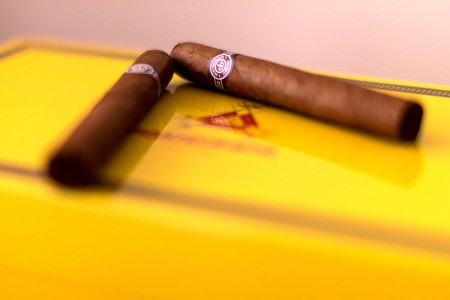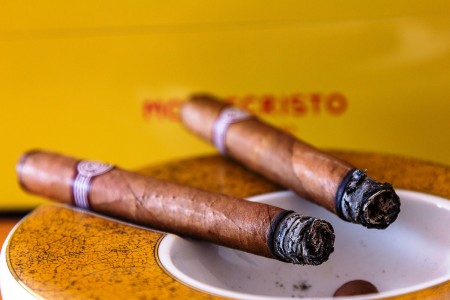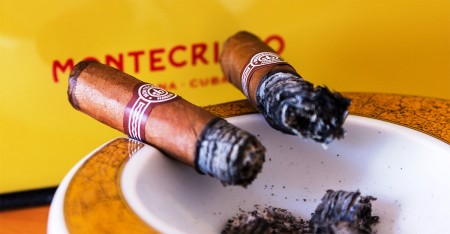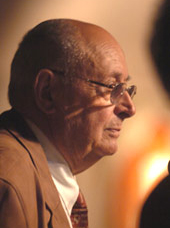A few months ago we posted an article called “The Bands: the Whole Colour of Tobacco”, which was part of a relatively new cigar magazine called CigarsLover. Based in Italy, the team behind this publication is doing a great job and each issue is better than the previous one. Today we’re posting an article written by Heiko Blumentritt from the most recent issue, which you can download here.
Smoking could be only a mere pleasure, but sometimes it could also be a scientific experience, pursuant to “La Méthode de Jacques Puisais”, or “The Method of Jacques Puisais”.
Mr. Puisais, the director of the French Institute of Taste, developed his personal theory about the lighting of the cigar. The flame emits a relevant heat, which creates a temperature gap between the head and the foot of the cigar; for this reason if you light up a cigar after having cut – or punched – its head, part of the smoke ends up in the middle of the cigar. This phenomenon leads to some negative aspects and it influences the taste in a significant way. His recommendation is to light up the cigar without cutting it before, and to blow on its foot before starting to smoke it, so that the impurities arisen with the heat can be expelled.
Jacques Puisais is a renowned character who made a big effort in the Taste field research. Many experienced smokers, in the field of food & wine, with well educated taste buds, are committed supporters of this theory, so this pushed me to give it a try.
I have been using this method for 4-5 years, and I tried it with various cigars. The test for this article has been led with a Montecristo No. 4.
For this test, two cigars of the same type have been lit up at the same time (using a non jetflame lighter). One of the cigars have been cut after the lighting, blowing through it before to make the first puff. The other cigar has been cut and lighted up after heating its foot until the burn was even (the first puff has been taken without blowing through the cigar).
The question now is: is there any difference between the two cigars?
As far as I’m concerned the answer is yes, especially for the first third.
One possible explanation is the “Chimneystack effect” inside the cigar, as claims Puisais. The lighting of a cigar gives off a strong heat and the smoke emitted looks for a way out. With the head cut, part of the smoke goes through the body of the cigar, releasing several impurities on the tobacco leaves. The part near the foot is the most affected one by this phenomenon, and this could be a possible reason why the first third is the most negatively influenced part.
The smoke regularly passes through the cigar during the smoking process. So why does the problem only come up during the lighting? Probably it is because the temperature of the lighter’s flame is much higher than the one kept by the cigar when it is lit. This theory finds its validation in the fact that smoking very fast involves an overheating and, what is important, usually makes the cigar bitter and unpleasant.
This is obviously only theory, but it is convenient to test it with the practice. In order to figure it out, the only thing we can do is smoking two cigars in parallel, simultaneously. That is exactly what we did, and the following is our report, where cigar 1 is the one lit with the Puisais Method and cigar 2 has been cut before lighting it up.
First Third
Cigar 1: the opening is really creamy, with rich notes of cocoa and delicate aromas of coffee, with hints of chocolate and milk. The aromas are well combined.
Cigar 2: the opening is sour, notes of coffee and spices (black pepper) are highlighted.
Second Third
Both the cigars develop the same aromatic palette, and no differences have been noticed. The woody aroma (cedar) plays the main role, followed by coffee and leather.
Third Third
The cedar and leather notes increase in intensity. Every puff develops toasted aromas. The two cigars show some slight differences. While cigar1 is still really creamy and pleasant, cigar2 is the first one to rest in the ashtray. Since we smoked both of them with the same rythim, we exclude that this happened beacuse of an overheating.
Conclusion
The cigar 1 lasted 65 minutes, without any combustion issue. I had to put it down to not burn my fingers.
The cigar 2 lasted around 50 minutes and some burn corrections were necessary. It got bitter in the last third.
With this article we don’t want to say that Puisais Method is the correct one and the “traditional lightning” is not. We just want to make you curious about it and perhaps make you try it out!





Charbel, honestly speaking I was waiting for that comment. Please explain me why the lighter weighted Montecristo No. 4 which I lit before cutting lasted longer than the one with the higher weight (cut before lighting).
As I said before: everybody should do like he prefers it. I found out for me to have an advantage for the pleasure of smoking when I do it in that way.
I light my cigars in a similar fashion, where I don’t draw in the flame as I light it. I cut it first then go after the binder on the foot of the cigar and once the ring is light then I draw. The cigar starts out smokey but the full flavor of the cigar remains till the end without any bitterness.
Thanks, -john. Cigar passionado
The difference between each individual cigar is to big to make this study valid. For example, the weight of a cigar from the same box may differ a lot, which , for example, might be the reason for the different smoking time as well as a different drag-properties (leading to different burn properties and tast-defferences). In the end, the beauty of cigars are, being handmade and individually different, in taste and properties. Otherwise we could just as well smoke machine made.cigarillos…
More on this subject:
http://www.friendsofhabanos.com/forum/index.php?showtopic=92997
No problem at all, Matthew and also thx for the good wishes.
To see the difference you have to make a side-by-side comparison, absolutely true.
I am not sure about the fact if you need much more flame to fire it up but independent of the way you light it up, you should always make it slowly and take your time. For me the lighting time makes no big difference if cut before or after.
Honestly I am not a big fan of cedar splits, I am afraid a little bit of possible soot etc., therefore I prefer the clean flame of my lighter. But that is also a personal preference. As I said at other places: there is no wrong or right.
I should have read Denis’ introduction closer because I missed that this was one of your articles, Heiko. Happy belated birthday, brother!
I’ve tried this the past few nights, and cannot be sure how beneficial the results are without a side-by-side comparison. My concern is that it takes quite a bit of flame to get the cigar going without the draw of oxygen over the tobacco. Belligerent Badger, I imagine it would be nearly impossible to use the Puisais method with a cedar split.
I have done a side-by-side comparison of a soft flame to a torch flame and did not see a significant difference in the cigar’s flavors. I did not think to note if either lighter resulted in more touch-ups or a longer smoking time.
I use always a softflame, Belligerent Badger, like my Dupont lighter. Only when I smoke outside I use a torch but try to put the far away enough from the foot.
Matthew, Mike, Marc and Jimmy: thx for your positive feedback to this article.
I am a long time avid cigar smoker. I have never heard of this method in all my years, and I tried it tonight with surprising success. Thanks for the tip. Always fun to learn new tricks for old habits.
Along the same line, is to toast the foot and use a more natural flame like that supplied by a strip of Spanish cedar. I’m not much of a fan of the welder’s torches in such ubiquitous use these days. They’re excellent if I need to braze brass together, but we’re lighting cigars here. The blue flame “windproof” butane lighters can produce temperatures of up to 2,500°F at high velocity. A soft butane flame is much lower, near 1,800°F. A match, or strip of Spanish cedar burns at about 1,300°F.
I’ve been using this method for some time since reading an article about the subject and have found that it works better, especially for bitterness and 1st third. The only drawback is that it’s a bit tricky, especially if you prefer punch cuts as I do, and you will have to refill lighters a lot for frequently due to the amount of time it takes to light the foot without a prior cut. So while this method might not be practical while on the road, it’s what I follow religiously while at home. Probably for serious cigar geeks either way!
Often use the pusais method, conditions permitting and have noted the same difference, particularly in thinner cigars.
Terrific analysis! I generally say that that how the cigar is lit doesn’t matter, but without scientific observation, it’s simply my uneducated opinion. I’m giving the Puisais method a try tonight. Thanks!